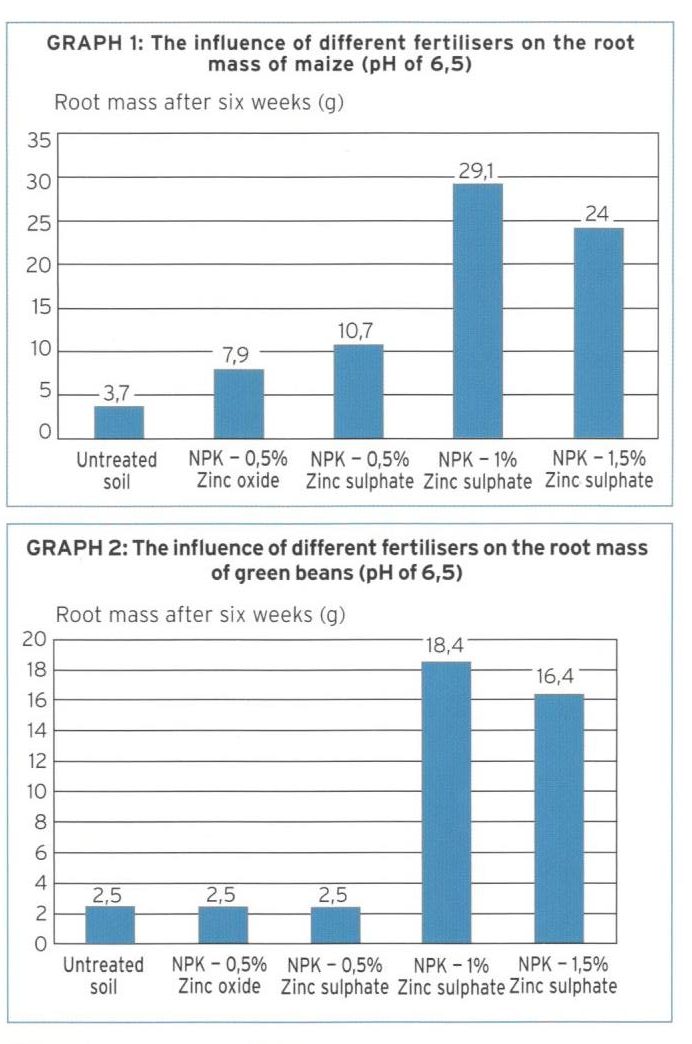South Africas average maize yield increased by 350% over the last 50 years, from less than a ton per hectare to 3.5 tons per hectare. This increase can be attributed to an increase in fertilizer use and cultivation, better cultivars and improved weed, disease an insect control methods.
Dr. Johan van Biljon, says that despite all these technological advances, soil acidity is still a major threat to optimal crop production. Soil acidity greatly affects the efficient uptake of plant nutrients. Other important aspects that need attention are the increase in soil organic matter content, improving the efficiency of applied fertilizer and the defining of the threshold values of micronutrients.
Researchers and agriculturists are concerned about the current micronutrient situation. In general farmers are well aware of the macroelements i.e. nitrogen (N), phosphorus (P), potassium (K) and the secondary elements calcium (Ca), magnesium (Mg) and sulpur (S). The importance of micronutrients is not as well known as macronutrients are.
The seven most important micronutrients are Zinc (Zn), Copper (Cu), Manganese (Mn), Molybdenum (Mo), Boron (B), Iron (Fe) and chlorine (Co). Our product combines 5 of the 7 into a watersoluble micronized powder that gets coated onto a fertilizer or seed with a natural binder.

Today more emphasis is placed on the importance of micronutrients in the nutrition of people and of animals than in the past (especially zinc and iron). Scientists all agree on the importance of micronutrients in plant growth and thus the potential yields. A deficiency of only one of these elements can lead to huge yield losses, and is probably one of the reasons that yields are lower than anticipated. However, over-fertilization of secondary macro-and micronutrients is costly and leads to unnecessary high production costs.
Dr John Mortveldt, retired professor and advisor on soil health, warns un the publication on Micronutrients that micronutrient deficiencies in certain crops are on the increase. The main contributing factors are higher yields under more intensive agricultural practices. Higher levels of NPK applications coupled with lower levels of micronutrients and reduced use of organic material.
The availability of micronutrients in the soil is mainly unfluenced by soil acidity. An article in Plant Nutrients published by the North Carolina Department of Agriculture and Consumer Services, stresses the importance of lime applications to reduce the acidity in soil.
A pH of 6,0 to 6,5 is preferable to make nutrients available for plants. Microbial activity in the soil will also increase at this pH level. Microbes help to transform soil nitrogen and phosphorus into a form more readily available to the plants. Lime applications also improves the soil’s physical properties, which in turn improves the movement of water and air in the soil.
THE ROLE OF MICROUTRIENTS
Zinc activates enzymes, regulates cell pH, plays a key role in chlorophyll and growth hormone formation, and is a catalyst in some growth reactions. Typical deficiencies occur in zinc deficient soils but can also occur in soils with pH levels and very high phosphate levels. This deficiency has a negative effect on cell development , size and structure.
Scientists all agree on the importance of micronutrients in plant growth and thus potential much higher yields.
Manganese plays a role in the photosynthesis and oxidation-reduction reactions in the plant such as the reduction of nitrates to amines. It enhances the functioning iron in the plant, as well as enzyme activity. It reduces the uptake of nitrates. Manganese is fairly immobile in the plant.

Copper is mainly found in active growing plants and seeds. It regulates certain processes in the plant, plays a role in forming chlorophyll formation and in the intake of iron.
Iron plays a key role in oxidation-reduction reaction in the plant and in chlorophyll formation. It occurs in some enzymes and certain proteins. Deficiencies occur mainly in alkaline soils.
Boron is found in all parts of the plant. It promotes cell division and maturity and plays an important role in the translocation of carbohydrates. It is essential for pollination, flower and fruit formation and in the production of proteins in the plant. Boron enhances the uptake of calcium, potassium and other nutrients. Deficiencies occur in soils with either a too high or too low pH and on leached sandy soils. The difference between a boron deficiency and toxicity levels is very small and therefore applications must be handled with caution.
Molybdenum is essential in very small quantities. It plays an important role in the reduction of nitrates in the plant and in the protein synthesis. Deficiencies mainly occur in leached acid soils. Molybdenum is also essential in the formation of root nodules in leguminous plants and in nitrogen fixing.
All the above mentioned Micronutrients are available in a single composition that can be bonded to a seed or fertilizer available from WSC . Our product is 100% watersoluble and we use a natural binder to coat either MAP/NPK or seed.

